Paludiculture Newsletter 1|2025
General information on peatlands and paludiculture
Peatland & Futurium
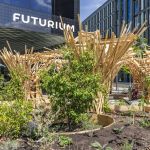
Land use is the focus at Berlin's Futurium over the next six months. Of course, peatlands must not be missing. In a cooperation we have placed them on the agenda – with two events in fall and in a living plant installation on the forecourt.
Just a few steps out of Berlin Central Station along the banks of the Spree and you can already see it: a living plant installation in front of the Futurium. Also integrated: Cattail and peat moss! They are intended to show that peatlands are important when it comes to land use. A joint event organised by Futurium, the Joachim Herz Foundation and the Greifwald Mire Centre on 9 October 2025 will focus on how we currently use peatlands, what problems this causes, what opportunities they offer us for the future and what conflicts there are over land use on peatland. At the Futurium's Family Day, already on 4 October 2025, we will present interesting and entertaining facts about peatlands and climate protection interactively for adults and children to participate in. Detailed information will follow soon on the Futurium and Greifswald Mire Centre channels. Until then, just drop by if you get the chance, perhaps during a stopover at the main railway station.
See peatlands and estimate greenhouse gas emissions
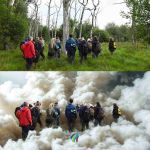
Estimating greenhouse gases - is in demand for GHG balances, life cycle analyses and certificates. But how can this be done for large areas without measuring stations? The Greifswald Mire Center is providing an apt method – GEST. You can enroll on a waiting list for the training course.
GEST stands for Greenhouse gas Emission Site Type. The idea is to determine the greenhouse gases produced by water levels, land use and vegetation. Those interested can still be put on a waiting list for the course from July 2-4 in Greifswald.
Participants will learn:
- to record water levels in the field
- to create a greenhouse gas balance sheet and determine the potential savings
The practical application takes place in two mapping exercises - in a degraded grassland in the Ryck lowlands and on the unused wet site.
In addition, the following questions, among others, will be discussed:
- How can the GEST approach be classified in the climate policy framework and what other areas of application are there?
- How trustworthy are carbon certificates and what criteria are needed for them?
The course is aimed at anyone who would like to be involved in the planning or implementation of peatland and climate protection projects. There is currently a waiting list and the course fee is 370 Euro (reduced rate 220 Euro). Knowledge of botanical species is a prerequisite, previous knowledge of peatland and climate protection projects is desirable. If you are interested in future courses, you may register by sending an e-mail to info@duene-greifswald.de.
More peatland specialists in MV - but qualified!

The first cohort seemed to be a success even before the start - more than 200 applications were received for the 20 places on the “MV Peatland Specialists” qualification programme, which was officially launched at the beginning of April.
On 4th April, the participants of the “MV Peatland Specialists” qualification programme welcomed at the State Office for the Environment, Nature Conservation and Geology in Güstrow (LUNG). Together with the Baltic Sea Foundation and the University of Greifswald, the LUNG would like to use the programme to meet the practical need for specialists for the rapid and large-scale implementation of peatland climate protection projects. Mecklenburg-Vorpommern and the other peatland-rich federal states are lagging behind in their own peatland and climate protection projects. According to the first peatland protection concept for Mecklenburg-Vorpommern (2009), the rewetting of 49,000 ha of peatland was planned by 2020. This has actually been implemented on around 35,000 ha to date. With 13 % of the state's area, peatlands play a major role in climate protection in MV. Drained areas are responsible for at least a third of total greenhouse gas emissions here. In order to become climate-neutral by 2040, 9,000 ha per year would have to be rewetted in MV and 50,000 in Germany. 20 projects are in preparation for this in MV - a lot of work for future peatland specialists.
Over the next five years, the participants will spend time at three places of employment in MV. The theoretical training will be provided by the University of Greifswald. The programme, which is looking for graduates (B.Sc., M.Sc.), engineers and career changers, is intended to serve as a model for other peatland-rich federal states. The prospective peatland specialists already come from many federal states; only one third of the participants are from MV. From next year's cohort onwards, there will also be places of assignment in other federal states.
As a pilot project, 90 % of the "MV Peatland Specialists“ programme is funded by the federal government (BMUV/BfN approx. 30 million Euro) from the Natural Climate Protection Action programme, approx. 5 % from the special fund for the promotion of natural climate protection of the State of Mecklenburg-Vorpommern and approx. 5 % from the assignment locations.
More information: https://www.regierung-mv.de/Landesregierung/lm/Service/Presse/Aktuelle-Pressemitteilungen/?id=209797&processor=processor.sa.pressemitteilung
Kicking off WETSCAPES 2.0
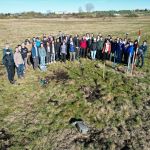
With funding of the German Research Foundation this ambitious project is uniting a consortium of more than 50 scientists from various disciplines on rewetted fens in Mecklenburg-Western Pommerania.
WETSCAPES 2.0 (Link: WETSCAPES2.0 - Fakultät - Universität Greifswald ), a large, interdisciplinary science consortium dedicated to researching rewetted fens started beginning of April with a two day meeting at Rostock University of more than 50 scientists from diverse fields, including 22 Principal Investigators (PIs) leading various subprojects, along with many Early Career Researchers (ECR).
Their diversity highlighted just how complex and ambitious this research programme funded by Deutsche Forschungsgemeinschaft is, aiming to investigate approximately 100 screening sites, five core sites, and two landscape-level experiments in rewetted peatlands of Mecklenburg-Vorpommern. This federal state has rewetted already more than 10 % of its peatland area and is frontrunning in developing solutions for wet peatland use (paludiculture, carbon credits, nature tourism, peatland photovoltaics). Now, the CRC will add a massive effort in fundamental research in rewetted fens.
The kick-off included a trip to one of the planned screening sites, where installed the first of our 1,000 sensors used for the project’s data collection! For some of us, it was the first visit of a North-German fen. They are almost everywhere and look often like 'normal' grassland!
Besides the funding of the Deutsche Forschungsgemeinschaft (DFG) - German Research Foundation, the Transregio Collaborative Research Centre (CRC) 410 is additionally supported by the Universities of Greifswald and Rostock , the Leibniz Institute of Freshwater Ecology and Inland Fisheries (IGB), Humboldt-University Berlin, the GFZ Helmholtz Centre for Geosciences, the Max Planck Institute of Biogeochemistry and the Ludwig-Maximilians-Universität München.
Policy briefs in four languages

What EU policy can do to restore degraded peatlands is shown in information prepared for decision-makers at national level.
A new policy brief, published in English, French, German and Dutch, sheds light on how EU policy can contribute to the restoration of degraded peatland ecosystems. In particular, it takes a close look at the EU Nature Restoration Regulation (NRR) which sets legally binding restoration targets for the Member States of the European Union. Country fact sheets for Austria, Belgium and Germany supplement the policy brief. They analyze the restoration targets according to NRR Art. 11.4 on peatlands currently used for agriculture and provide important information for national strategies and decision-makers to promote the implementation of the restoration goals. The policy brief highlights the enormous importance of wetlands - especially peatlands - for climate and biodiversity protection and stresses the urgency of their restoration.
The policy brief and country fact sheets were produced in cooperation with the ALFAwetlands and WET HORIZONS projects. As case studies, the country profiles present the Living Labs of the ALFAwetlands project: the Zwarte Beek valley in Belgium, Lake Neusiedl on the Austrian-Hungarian border and the Upper Peene Valley in Germany.
Being in demand as an environmental engineer
Now that the boomer generation has retired, graduates of the comprehensively reformed ‘Environmental Engineering’ degree programme at the University of Rostock have good prospects - especially with a focus on water. Peatlands are a suitable field of activity.
The realisation of the ambitious goals for water and climate-friendly land use and water management is also highly dependent on the availability of experts at public bodies, authorities, planning and construction companies. With the retirement of the ‘boomer generation’, there is currently a high demand for well-trained graduates at the interface of environmental and engineering sciences.
Meeting this demand is a key objective of the comprehensively reformed Master's degree programme in Environmental Engineering at the University of Rostock. It builds consecutively on the Bachelor's degree programme of the same name, but was also deliberately opened up to ‘lateral entrants’ from other subject areas. The main aims of the reform were to achieve better integration within the Faculty of Agriculture, Civil Engineering and Environment, to address important time-related issues more effectively, to improve studyability and to enable students to develop a more intensive profile.
As part of the reform, the compulsory area was significantly reduced in favour of the compulsory elective area. All specialised modules are now assigned to four profile lines as compulsory or elective modules, at least one of which must be successfully completed:
- civil and coastal hydraulic engineering with a focus on structural civil engineering and infrastructure construction
- technical environmental protection with a focus on environmental technology in the fields of energy, water and recycling management
- environmental analysis and resource protection with specialisations in the fields of environmental data acquisition and assessment, modelling of environmental systems and preventive environmental protection
- sustainable environmental planning with a focus on spatial planning on various scales
Three interdisciplinary compulsory modules give all students a broad overview of the diverse fields of activity of an environmental engineer and teach important scientific and practical working methods.
A strong focus of the degree programme is traditionally water management and hydraulic engineering at the landscape and settlement level. The programmes can be roughly divided into hydrology and water resource management, urban water management and coastal hydraulic engineering. Important analytical and problem-solving skills for integrated land use and water management are taught. Redesigned modules combine modern methods and digital tools with realistic applications. The aim is to prepare students specifically for the needs of water management authorities, planning companies and specialised administration.
Enrolment is possible for the winter and summer semesters. Further information: https://www.auf.uni-rostock.de/studium/masterstudiengaenge/umweltingenieurwissensch/
Author: Prof. Jens Tränckner, Uni Rostock
The Paludiculture Interview
In the best case scenario, I don't have to hear anything

Alexander Drexler records biodiversity via audio. Bioacoustic monitoring is the technical term for it. For the PaludiZentrale project, he uses it to record biodiversity on areas before and after rewetting, in particular before and after cultivation in paludiculture
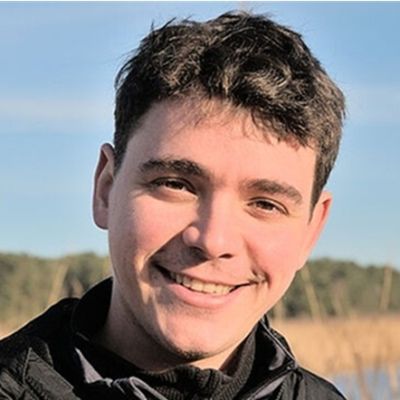
What does bioacoustic monitoring actually look like? Looking out for dragonflies and then holding the microphone close to them? No, in bioacoustic monitoring we record the vocalisations of species with permanently installed microphones. The sounds are of animal origin. We evaluate these recordings and draw conclusions about the species present.
It's pretty clear with birds, but insects? Which species can you record? It's true, I can record a lot, but the question is how well it can be analysed. Bird song is usually unambiguous and can be analysed well using artificial intelligence (AI). This also works for some insects such as grasshoppers. But for bees, for example, I am not yet aware of any analyses. We also record bats. The difficulty here: We can't hear their ultrasonic sounds with our ears. There are special devices for this, but identifying individual species from their calls is not easy. It is at the limit of what our devices can do, but it is feasible. It is also conceivable, for example, to record amphibians, possibly even insects under water. Scientists from Manchester are trying this.
What is the advantage of bioacoustic monitoring? The method is not tied to a specific time or person. The interference with nature is minimal and enables comparable results from recordings in different areas. We do not scare up any animals and do not remove them. For comparison: when mapping birds, people could never map for as long as our devices record. For bats, netting would be the alternative. In contrast bioacoustic monitoring is passive and we only have to intervene minimally in nature.
How did you come across this method? I came across it during my studies with Prof Dr Frank Dzoizck at the Dresden University of Applied Sciences. I also have a slight affinity for technology and have built audio recorders for the university and other organisations, for example for projects or planning offices.
This easily adds up to hundreds of hours of audio recordings - it's difficult to listen through... In 2024, we collected around 12 terabytes of data, that's around 30,000 hours played in a row, which would take more than three years to listen through it. Of course, I can't manage that. In the best-case scenario, I actually don't have to listen to almost any of it, because that's where the AI comes in. We have a semi-automated process in which I ‘only’ listen to some of the results. We want to find out how often the AI is uncertain per species. We know that it has an error value because, for example, there is a regionality, i.e. something like a dialect, in the calls of the birds. To determine this error or validate the results of the AI, we listen to 300 random calls from each bird species in audio snippets of three seconds each for different locations. We also look at temporal regression, as it is unlikely that a bird will only call or sing once. In the end, we not only identify the species, but can also make good statements about phenology, i.e. the presence and behaviour of a species over the course of the year. However, it remains difficult to determine the number of representatives of a species.
Isn't that boring? Yes, it is boring. We need at least half an hour per species for validation and we expect around 200 species on the test areas.
200 species sounds like a lot. Does that already allow you to make a statement about paludiculture areas? We have only just completed the field surveys and are currently analysing them. We can't make a statement yet.
What was the most beautiful sound of the monitoring? Or is it impossible to say? I can‘t tell yet. I've only listened to it as a test. And with bioacoustic monitoring, the aim is really that we don't have to listen to everything ourselves - in the best case scenario.
To be specific - what have you already found? We are not there yet. At PaludiZentrale, we ensure that the areas of nine projects are recorded in a monitoring programme over ten years according to the same and comparable standards. The analysis will therefore take some time.
Interview by Nina Körner.

Field work with Alexander Drexler (Photo: S. Arbeiter).
News from paludiculture projects
PaludiPrealps
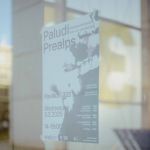
In the Paludi Prealps exhibition, students presented what can be created by combining architecture and design with material from peatlands.

On 5 February 2025, the and collective of the Chair of Architecture and Design (and Studio) at the Technical University of Munich (TUM) presented various student works relating to paludiculture in the foothills of the Alps in the Paludi Prealps exhibition. The exhibition was accompanied by a programme of guided tours, workshops and short films.
At TUM, architecture is not only understood as the art of building, but also as an instrument for researching complex ecological challenges. The professorship's Bioregional Design Lab is dedicated to the rewetting of peatlands, the use of bio-based materials and the development of regional value chains. Over the past semester, the Master Studio has developed nine innovative projects through excursions, interviews and research. These range from craft projects such as the production of the FL0 chair series from birch wood and woven rushes to innovative approaches such as the production of birch pitch as a sealing biopolymer and the PaludiDinner culinary journey with edibles from the peatland.
A central highlight of the exhibition was the panel discussion in which representatives of the regional agricultural offices, the Bavarian Farmers' Association and committed entrepreneurs discussed the transformation towards a sustainable Paludi economy. The event attracted a broad audience: Paludi experts, farmers, politicians, students and researchers took part in the exhibition and provided valuable input.
The examination of paludicultures is currently being further intensified in summer: 25th-30th May 2025, Mecklenburg-Vorpommern. The Paludi Malchin Summer School, organised by TUM in cooperation with RWTH Aachen University, the Malchin-Stavenhagen Water Association, the Thünen Institute, the Greifswald Mire Centre, the Moortheater and other partners, offers students and pupils the opportunity to work directly with peatland materials. The central project is the Paludi Pavilion - a structure made of regional peatland wood, clad with sustainable materials and integrated into the landscape.
Autoren: Thiade Langenhan & Jan Gutjahr, TUM
Paludiculture in a garden box
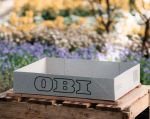
The “Alliance of Pioneers” of the toMOORow initiative, the nationwide demand alliance for paludiculture, has a new pilot product: the company OBI now offers an alternative packaging for transporting plants - a cardboard box containing 10% paludiculture biomass.
"Achieving mo(o)re together" - this is the motto under which OBI Group Holding, a member of the „Alliance of Pioneers“, launched its first paludi pilot product in April: a box for transporting plants made from 10% reed canary grass. From the “field” to the OBI store, the box passes four different stations:
At the Swabian Donaumoos-Zweckverband, the reed canary grass is harvested on rewetted peatland in the Donaumoos. The company Fiber365 processes the paludiculture biomass into fibers using an innovative, environmentally friendly process. The LEIPA Group uses a mixture of these fibers, among others, to produce a cardboard base. Leopold GmBH Verpackungen then uses this to produce the actual cardboard. This is intended for customers to transport small plant pots from the markets to their homes. In Germany alone, the DIY and garden market sells around 46 million plants every year.
Ground-breaking ceremony at Sernitz
The symbolic ground-breaking ceremony at the beginning of April marked the start of the establishment of a wet meadow paludiculture as part of the toMOORow initiative - wet peatlands for a sustainable future. The aim of the project is to preserve peatlands as natural carbon reservoirs, promote biodiversity and enable sustainable land use. Together with representatives from politics, science, business and civil society, a significant contribution is being made to climate protection and adaptation to climate change - a view shared by the then Federal Ministers Steffi Lemke and Cem Özdemir.

With the toMOORow initiative, the Michael Succow Foundation, partner in the Greifswald Mire Centre, and the Michael Otto Environmental Foundation are sending a strong signal for sustainable peatland use. The „Torfwiesen“ site in the Sernitz peatland serve as a model project: drainage ditches are now being filled in here, sills are being built in the stream to retain water and sustainable use through paludiculture is then being established with local farmers on an area of around 80 hectares.
The initiative is thus continuing years of work to restore natural conditions in the Sernitz Peatland in the “Schorfheide-Chorin” biosphere reserve as part of the LIFE “Lesser Spotted Eagle” project. In consultation with local residents and land users, measures for water retention were developed, pastures for water buffalo were established and a moor experience trail was designed, to name just a few examples of the successful project.
As part of the toMOORow initiative, the Sernitz peat meadows are also being worked on with the aim of managing wet meadows and raising the water levels of the peat meadows. The measures help to keep water in the landscape, reduce greenhouse gas emissions by up to 1,200 tonness of CO₂ equivalents per year and enable the reintroduction of typical peatland plant and animal species.
The ground-breaking ceremony was attended by high-ranking political representatives. The then Federal Environment Minister Steffi Lemke emphasized the importance of peatland rewetting for achieving Germany's climate targets:"Intact peatlands are good for the climate. They store carbon and are a unique habitat for many endangered species. The rewetting of moors is necessary to protect our climate. For farmers, the management of moors using adapted techniques such as paludiculture or water buffalo can create reliable and sustainable sources of income. The Sernitz peat meadows are such a lighthouse project because it brings together natural climate protection and sustainable land use. The rewetting of peatlands is one of the most effective measures for climate protection. Projects like this show how we can combine climate protection, nature conservation and economic prospects."
Cem Özdemir, then Federal Minister of Agriculture, also emphasized the role of sustainable agriculture: "Rewetted peatlands are indispensable for active climate protection and the protection of biodiversity. It is crucial that we work together with all stakeholders to find forward-looking solutions that are also financially viable for farmers. Paludiculture offers an innovative perspective here. It is precisely this combination of protection and benefit that the toMOORow initiative is pursuing. It impressively demonstrates how climate protection and economic activity can be brought together for the benefit of our livelihoods and the development of rural areas. We need to think about the protection of peatlands and sustainable agriculture together. With paludiculture, we can create land use that is sustainable in the long term and protects the climate at the same time."
In addition to the ecological benefits, wet meadow culture also offers economic opportunities. Through the targeted introduction of paludiculture, wet biomass can be used as a sustainable raw material - for example for the production of packaging materials and building materials or as animal feed. The aim is to strengthen regional value creation and develop new, environmentally friendly economic models.
Further information at www.tomoorow.org
Source: Succow Foundation press release: https://civicrm.succow-stiftung.de/civicrm/mailing/view?id=915&reset=1
MOOReturn

Large-scale rewetting of 300 hectares is the aim of the MOOReturn project, which was launched in January. The material and thermal utilisation and the marketing of paludiculture biomass is also part of the project. Text: Covering a total area of at least 300 ha, the MOOReturn project will combine the large-scale rewetting of peatland with the cultivation, material and energy recovery and marketing of paludiculture raw materials from January 2025. With estimated CO2 savings of 3,400 tonnes per year, “MOOReturn” will make a significant contribution to the goals of the National Peatland Protection Strategy and the federal-state target agreement on peatland protection.
Along the Upper Peene in the vicinity of the town of Malchin (Mecklenburg Lake District), the focus is on peatland revitalisation, water level optimisation and biomass harvesting on various peatland areas. A further aim is to demonstrate an economical and residue-free treatment process for the utilization of peat biomass on an industrial scale in the region. New possibilities for pulping and recycling as paper or packaging material, fiberboard and building materials as well as for chemical raw materials are to be tested. The degressive thermal utilisation supports the development of progressive material utilisation at the beginning and enables an increased own use.
Residual materials are to be marketed as by-products (e.g. fertilizer granulate production). The planning and implementation of the water level increases and the recycling routes will be accompanied by scientific studies and measures for public relations and knowledge transfer.
The Federal Ministry of Food and Agriculture (BMEL) is initially funding the MOOReturn project in Mecklenburg-Western Pommerania until 2027 with 4.3 million Euros from the Climate and Transformation Fund. The project is scheduled to run for a total of 10 years, making it one of the model and demonstration projects for paludiculture in the nationwide PaludiNetz. Under the leadership of the German Biomass Research Center (DBFZ), a total of nine partners from science, administration and industry are involved. The Universities of Greifswald and Rostock are supporting MOOReturn with greenhouse gas measurements and systematically recording flora and fauna. The University of Bonn is investigating material recycling. The University of Greifwald is also supporting the town of Malchin in selecting and analyzing areas and developing concepts for the appropriate use of the land. The Michael Succow Foundation and the Wasserwerk der Zukunft e.V. association are shaping the communication processes in the region, preparing the results for the public and decision-makers and offering regional and supra-regional education and knowledge transfer. The Werner GmbH and Agrotherm are also involved as regional agriculture supports the project.
The project was presented in the region at a public information event at the Hotel Basedow near Malchin on 10 April 2025 under the title “New utilization possibilities for peatland grasses” in the presence of the BMEL. Various aspects of the project were discussed with interested parties and questions were asked at discussion tables. Prior to this, a delegation from the BMEL, including Parliamentary State Secretary Claudia Müller, visited the project area and exchanged ideas with the project's regional partners.
More information: https://moor.fnr.de/aktuell/pressemeldungen/pressemeldungen/aktuelle-nachricht/projektstart-mooreturn
Author: Sophie Hirschelmann
Events
All current events are compiled in our online calendar.
Publications and literature
Nordt, A., Abel, S., Hirschelmann, S., Lechtape, C. & Neubert, J. (2024) Guidelines for implementation of paludiculture. Proceedings of the Greifswald Mire Centre 06/2024 (self-publishing, ISSN 2627–910X), 144 p.
Greifswald Mire Centre (2025) Der Beitrag von Paludikultur zum Erreichen der Umweltziele innerhalb der Gemeinsamen Agrarpolitik, Briefing Papers GMC
Greifswald Mire Centre (2025) New Developments in European Peatland Strategies, Briefing Papers GMC
Ross, K. (2024) Potential for Greenhouse Gas Emission Savings from Paludiculture. Department for Environment, Food and Rural Affairs, December 2024.
Ross, K. (2025) Potential Markets for Paludiculture Crops. Department for Environment, Food and Rural Affairs, March 2025.
Joel, M.F., Glina, B. (2025) Paludiculture Potential on Fen Peatland: A Soil-Based Case Study from Central Poland. Sustainability 2025, 17, 2431. https://doi.org/10.3390/su17062431
New information portal of the Agency for Renewable Resources
https://moor.fnr.de/aktuell/pressemeldungen/pressemeldungen/aktuelle-nachricht/neue-informationsquelle-zum-moorbodenschutz-online








